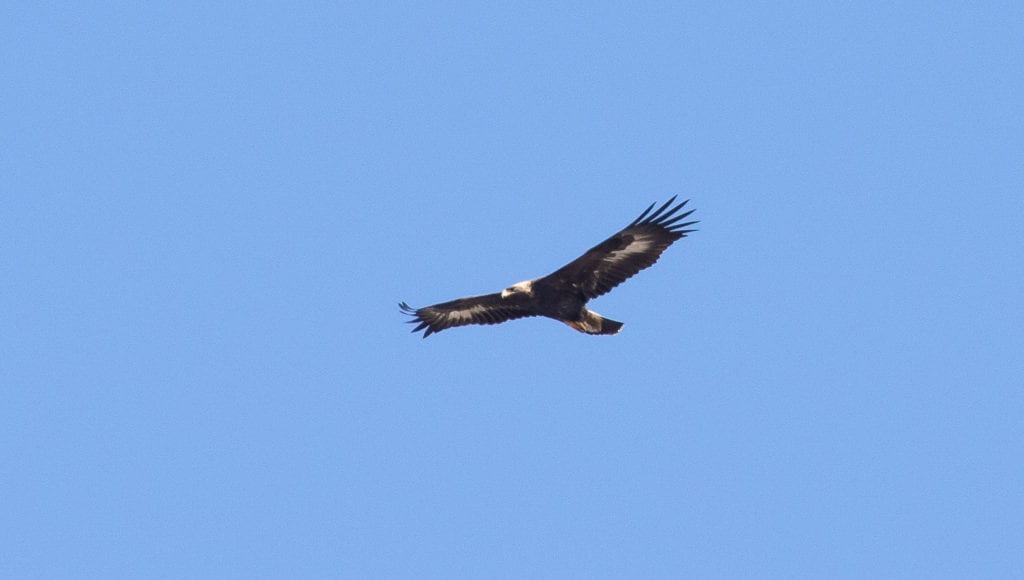Text and photos by Erik Bruhnke
2018 Cape May Hawkwatch Counter
Cape May Bird Observatory
This year marked the 43rd season of the Cape May Hawkwatch. There were many highlights throughout the season, and the remarkable total of 53,495 raptors, recorded between September 1 and November 30, represents the highest raptor count since 1999. September started out quietly, record-breaking highlights occurred throughout the middle portion of the migration, and solid late-season flights continued through the closing day. A grand total of 15 species of raptors were documented over the three months.
September was filled with a smattering of unseasonably hot days. The warm temperatures mixed with east and southeast winds to create lulls in the numbers of raptors detected daily. There was one catch to the less-than-favorable conditions… while these winds often keep many soaring raptors to the north (farther away from Cape May Point) they also bring raptors that might be migrating over the ocean into view from the hawkwatch platform. Despite these challenging winds, this season racked up the second highest seasonal Osprey count (6,064 individuals) and second highest seasonal Peregrine Falcon count (1,520 individuals) in the history of the Cape May Hawkwatch! Both of these raptors are known for migrating over both land and bodies of water. These species are sometimes seen at first light hauling across Delaware Bay, and they can also be seen mid–day soaring high overhead with the other raptors. A total of 11,986 raptors were counted during September. Early morning flights of warblers and other long-distance songbird migrants wowed visitors all month long.


October was filled with many cool days supported by north and northwest winds, conditions favorable for raptor migration at Cape May Point. On October 12th, the largest American Kestrel count ever documented from the Cape May Hawkwatch took place. These beautiful falcons were already aloft by sunrise, migrating through the early morning skies of violet and black. By day’s end, 5,406 American Kestrels had been tallied. Watching them was mesmerizing. Counting them was exhilarating. Witnessing that day’s migration felt like a dream. Fourteen of the 15 Golden Eagles observed this fall were also seen in October, part of the month’s total of 35,305 raptors. Aside from the raptors, a highlight was winter finch species that began moving through the area, such as Purple Finch and Pine Siskin.


Like October, November was filled with many cool days and northwest winds. We experienced numerous exciting flights of Red-tailed Hawks and Red-shouldered Hawks. Northern Goshawk numbers increased as the month progressed; all of the 17 Northern Goshawk documented this fall were seen in November. A strong Bald Eagle flight continued from the previous two months, reaching 921 individuals for the season – the highest Bald Eagle total ever compiled in Cape May hawkcounting history (the previous high was 672 in 2014) . A total of 6,205 raptors were counted in November.


Hawkwatches are great places to study raptors and non-raptors alike. One of the pleasures of the CapeMay Hawkwatch is its proximity to the ocean as well as its placement at the end of a prominent peninsula. Forests and marshes to our north offer shelter and food for a rich variety of birds migrating through the area. Beyond the tip of Cape May Point is the Delaware Bay and the Atlantic Ocean, which bring many offshore-dwelling birds into view. Just beyond the hawkwatch platform is Bunker Pond, an important source of food and fresh water to many waterfowl and shorebirds making their way through. The adjacent habitats of Cape May Point State Park are home to many year-round and migrating bird species. The overall bird migration this season lived up to Cape May’s claim to fame! The annual “inundation” of Yellow-rumped Warblers and high-flying American Robins took place. Swirling murmurations of Tree Swallows took our breath away as they flocked together for safety or merely took a break from eating the rich supply of bayberries. It is a great challenge putting this spectacle into words. These flights of birds will change the way you see the outdoors.

Winter finches were a noteworthy part of this fall’s highlights. Busy flocks of Purple Finches poured through the skies earlier on, followed by several Red Crossbills, Evening Grosbeaks, Common Redpolls, Pine Siskins, and thousands of American Goldfinches. Throughout the season, we also witnessed Sandhill Cranes flying by, a rare but annual treat for the area. A Little Gull was documented in November, only to be followed by a Black-headed Gull!


Every fall is different, and the world around us is ever-changing. Hawk counters do what we do for the love of bird migration and for the love of contributing to a better understanding of birds. A special shout out goes to Migration Count Coordinator Tom Reed for his support and skills as a relief counter. The 53,495 raptors counted this fall will take their place in the long-term analysis of population trends – just one of the important reasons for the migration monitoring being carried out. The camaraderie of everyone coming together again made Cape May a special place. Birds bring us together, and it has been a pleasure experiencing this migration with everyone who reads the blog and visits the hawkwatch.










